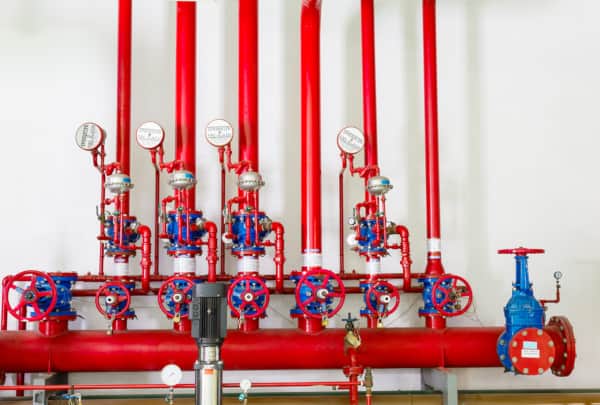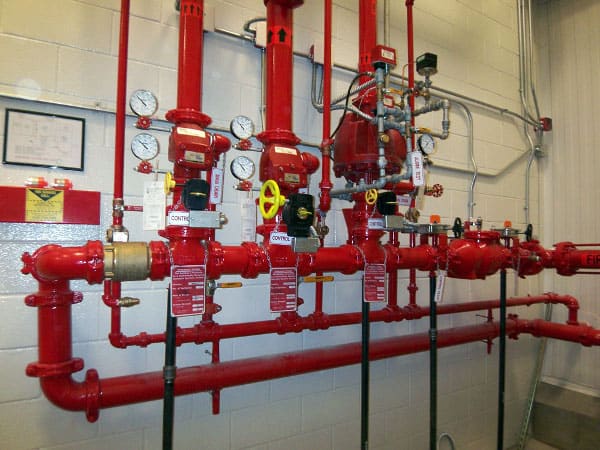
Breaking Down the Components of an Industrial Fire Protection Installation
Leave your thoughtsFire Protection Installation
Industrial facilities have many hazardous materials frequently used in production processes or stored on-site. But to prevent loss, businesses get industrial fire protection installation. These systems are expertly designed to protect valuable assets and the lives of those who work in these environments. But what comprises an industrial fire protection system? Let’s take a look at them.
4 Main Components of an Industrial Fire Protection Installation
In any comprehensive industrial fire protection system, four components work together to ensure safety and mitigate fire risks. Below is a detailed explanation of these components:
1. Fire Detection Systems
The fire detection system is the first line of defense in any fire protection installation. These systems use various methods to detect the presence of a fire. The primary components include:
2. Smoke Detectors
These devices sense smoke particles in the air and sound an alarm when smoke levels rise. They are often found in commercial kitchens, educational institutes, rooms, hallways, and other areas to protect visitors.
3. Heat Detectors
Heat detectors trigger alarms when they detect a rapid increase in temperature, indicating a fire. They are ideal for fire protection installation in places where chemicals are used or stored, such as in laboratories or industrial facilities, and can have chemical fumes that may interfere with the operation of smoke detectors.
4. Flame Detectors
Flame detectors are designed to recognize the visible and invisible radiation produced by flames. They are commonly used in oil refineries and gas processing facilities as they deal with highly flammable materials such as petroleum and its byproducts.
2. Fire Alarm System
When a fire is detected, a fire alarm system is crucial to alert everyone on the premises. These systems consist of multiple components in industrial fire protection installation. The control panel receives signals from the detectors and sound alarms, activates sprinklers or sends notifications to the authorities.
Moreover, they also have integrated audible and visual alarms, including sirens, horns, and flashing lights, to alert people of a fire. They are usually located throughout the facility so that workers and visitors present in any area are notified and start evacuating the building.
3. Fire Suppression Systems
In industrial settings, controlling a fire is as important as detecting it. Fire suppression systems are responsible for extinguishing or controlling the spread of fires. Key components include:
1. Sprinkler Systems
These systems operate by releasing water or other fire-extinguishing agents when a fire is detected. Manufacturing plants, warehouses, and distribution centers often utilize fire protection installation with sprinkler systems to prevent fires from spreading and causing extensive damage.
2. Gas-Based Suppression Systems
These systems release gases, such as carbon dioxide or FM-200, to reduce the oxygen levels in a fire and extinguish it. Gas-based suppression systems are crucial in data centers, server rooms, and laboratories, electrical rooms to prevent water damage to expensive electronic equipment.
3. Foam-Based Systems
Foam is used to smother the fire by covering the fuel source. It is effective in places with flammable liquids. For example, oil refineries use foam-based suppression systems to protect against fires that can occur during the processing of crude oil.
4. Fire Extinguishers
Fire extinguishers are small, multipurpose devices made to put out different kinds of fires. The following are the main types of fire extinguishers and their appropriate applications:
1. Water Extinguishers
These extinguishers function by putting out the flames and eliminating the heat source that keeps a fire going. Water extinguishers are filled with water, making them suitable for fires involving common combustibles such as paper, wood, and fabrics.
2. Dry Chemical Extinguishers
Dry chemical extinguishers are versatile and efficient for fire protection installation, including those involving flammable liquids, electrical equipment, and combustible materials. They contain dry chemical agents such as monoammonium phosphate or sodium bicarbonate, which overpower the flames and stop the fire’s chemical reaction.
3. CO2 Fire Extinguishers
Carbon dioxide (CO2) extinguishers are suitable for electrical fires as they don’t leave any residue and do not conduct electricity. They are commonly used in offices, computer rooms, and other locations where sensitive electronic equipment is present.
4. Foam Extinguishers
These extinguishers cover fires involving flammable liquids, such as gasoline, oil, and grease. They create a layer of foam that floats on the surface of the burning liquid, preventing the release of flammable vapors and cooling the fire.

Wrap Up
In industrial settings, fire protection systems are installed composed of fire detection systems, alarm systems, and various suppression methods, whether via water-based sprinklers, gas-based suppression, or foam-based systems. This complex network of safety measures detects fires early, alerts personnel quickly, and intervenes effectively.
And, if you need assistance with your fire protection installation, remember that TRINITI Fire Life & Safety is here to help. We are the go-to company for fire protection testing, maintenance, and repairs. So, don’t be afraid to reach out and up your safety game!
